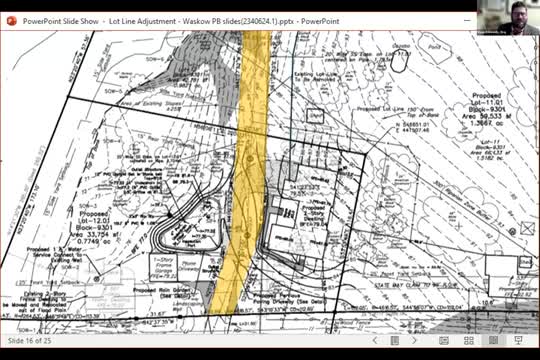Zoning Board Approves Controversial Variances for Historic Home
October 17, 2024 | Princeton, Mercer County, New Jersey
This article was created by AI summarizing key points discussed. AI makes mistakes, so for full details and context, please refer to the video of the full meeting. Please report any errors so we can fix them. Report an error »

In a recent government meeting, discussions centered around a proposed development plan that includes significant changes to two residential lots, necessitating several variances. The meeting highlighted the collaboration between the project team and town professionals to address zoning requirements and environmental considerations, particularly regarding the use of pervious pavement and the removal of existing pavement.
Key points included the identification of steep slopes on the property, which are over 25%, and the implications of a right-of-way dedication by the Department of Transportation (DOT). It was noted that the DOT typically does not compensate landowners for such takings, a point that surprised some attendees.
The project involves a land swap that has resulted in the need for variances related to lot area and depth. Specifically, proposed Lot 12.01 requires a variance for its area, which is less than the required minimum, and a front yard variance due to the right-of-way taking. The meeting also addressed the building height to setback ratio, which was recalculated to be more favorable than initially thought.
Architectural plans were presented, showcasing a new addition to an existing historic home. The architect emphasized a design that respects the character of the original structure while providing modern amenities. The addition will feature a low-profile design intended to blend into the landscape, with careful attention to the visibility of the garage, which is positioned to minimize its impact on the streetscape.
The meeting concluded with a discussion on the neighborhood character variance needed for the side-entry garage, which is designed to be less visible from the street. The project team argued that compliance with the ordinance would ironically make the garage more prominent, countering the intent of the regulations.
Overall, the meeting underscored the complexities of balancing development needs with zoning laws and community character, as stakeholders continue to navigate the implications of the proposed changes.
Key points included the identification of steep slopes on the property, which are over 25%, and the implications of a right-of-way dedication by the Department of Transportation (DOT). It was noted that the DOT typically does not compensate landowners for such takings, a point that surprised some attendees.
The project involves a land swap that has resulted in the need for variances related to lot area and depth. Specifically, proposed Lot 12.01 requires a variance for its area, which is less than the required minimum, and a front yard variance due to the right-of-way taking. The meeting also addressed the building height to setback ratio, which was recalculated to be more favorable than initially thought.
Architectural plans were presented, showcasing a new addition to an existing historic home. The architect emphasized a design that respects the character of the original structure while providing modern amenities. The addition will feature a low-profile design intended to blend into the landscape, with careful attention to the visibility of the garage, which is positioned to minimize its impact on the streetscape.
The meeting concluded with a discussion on the neighborhood character variance needed for the side-entry garage, which is designed to be less visible from the street. The project team argued that compliance with the ordinance would ironically make the garage more prominent, countering the intent of the regulations.
Overall, the meeting underscored the complexities of balancing development needs with zoning laws and community character, as stakeholders continue to navigate the implications of the proposed changes.
View full meeting
This article is based on a recent meeting—watch the full video and explore the complete transcript for deeper insights into the discussion.
View full meeting
